Welcome to the Ultimate Meat Grinder Buyer’s Guide!
Having the proper equipment in your kitchen is crucial for cooking tasty meals. A meat grinder is also an important necessity if you enjoy cooking with freshly ground meat. But with so many alternatives on the market, choose the best meat grinder can be a difficult task.
We’ve produced a complete buyer’s guide to help you make an informed purchase. We understand how important it is to locate the right meat grinder for your needs, preferences, and budget. This guide will help you every step of the way, whether you’re an experienced chef or a home cook looking to enhance your culinary skills. We understand the importance of providing you with useful information to help you go through the possibilities and find the appropriate meat grinder for you.
This post will go through the nine important features you should consider when purchasing a meat grinder. Everything will be discussed, including different types of grinders, power and motor strength, grinding capacity, material and durability, cutting plates and blades, simplicity of use and cleaning, safety features, noise and vibration levels, price, and warranty options.
Each factor will be completely clarified, giving you with useful insights and ideas to help you make an informed decision. We recognize that everyone’s needs and preferences differ, so we’ll give you with a number of alternatives and considerations to guarantee you select the ideal meat grinder for your unique needs.
So, whether you want to grind your own meat for burgers, sausages, or meatloaf, this instruction will help you. We aim to arm you with the information and confidence to select the best meat grinder that will become an indispensable part of your culinary arsenal.
Let’s go on this adventure together and explore the world of meat grinders. Prepare to have a more joyful and flavorful cooking experience.
Understanding Meat Grinders
Meat grinders are essential kitchen appliances that revolutionize the way we prepare ground meat. If you’ve ever wondered how your local butcher or gourmet chef achieves that perfect texture and freshness in their ground meat, the answer lies in the mighty meat grinder.
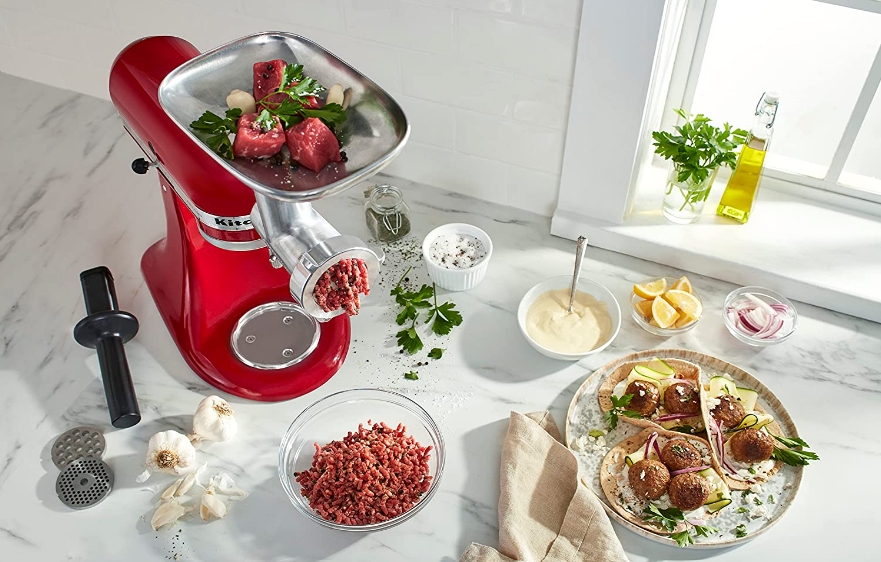
What is a meat grinder?
In simple terms, it is a kitchen tool designed to mince or grind meat into various textures, from coarse to fine. It allows you to experiment with different cuts and combinations while giving you complete control over the consistency, flavor, and quality of your ground meat.
How does a meat grinder work?
Well, it all starts with the main components: a hopper, a screw conveyor (also known as an auger), and a set of cutting blades or plates. As you feed the meat into the hopper, the screw conveyor pushes it towards the cutting blades or plates, where the magic happens.
The cutting blades or plates play a crucial role in determining the texture of the ground meat. Different types of blades and plates are available, allowing you to achieve anything from coarse ground meat for hearty burgers to fine ground meat for delicate sausages. By controlling the speed and pressure, you can achieve the perfect consistency every time.
Different types of meat grinders (electric, manual, standalone)
1. Electric Meat Grinders:
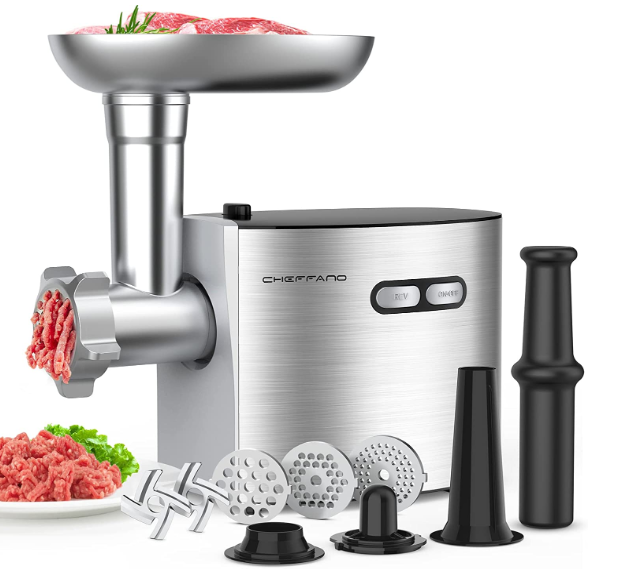
These are the most popular and convenient option for home cooks and professionals alike. Powered by electricity, these grinders offer effortless operation and can handle larger quantities of meat. They often come with various speed settings and additional features for versatility and ease of use.
2. Manual Meat Grinders:
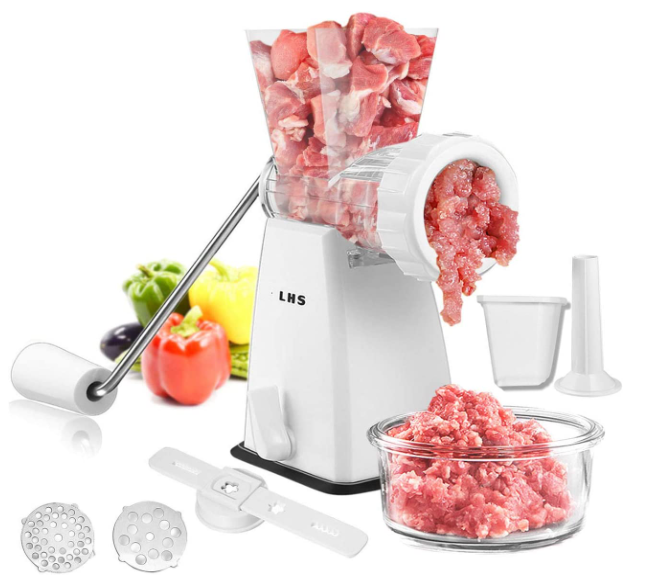
If you appreciate the old-school charm and a hands-on approach, manual meat grinders are a great choice. These grinders rely on your physical strength to operate, usually through a hand crank. While they require more effort, they are compact, portable, and perfect for smaller quantities of meat.
3. Standalone Meat Grinders:
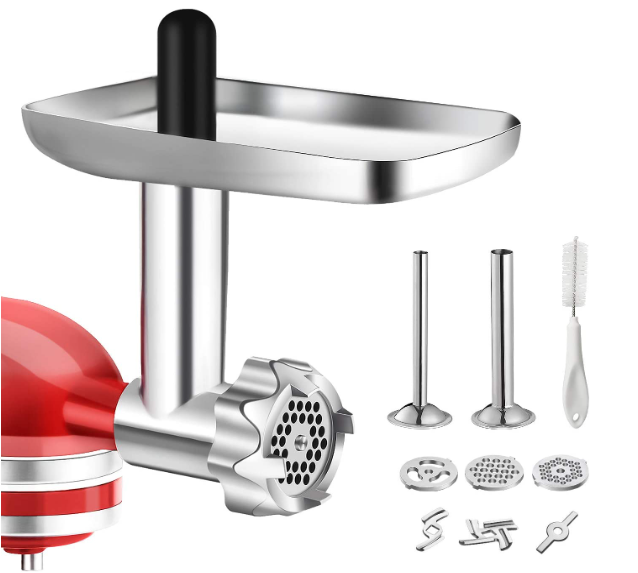
For those who take their meat grinding seriously, standalone meat grinders are the ultimate option. These heavy-duty machines are designed for commercial use or avid home cooks who process large volumes of meat regularly. They provide exceptional power, durability, and efficiency, but at a higher cost.
Depending on your unique needs, price, and kitchen space, each type of meat grinder has pros and cons. By understanding the differences between electric, manual, and standalone grinders, you can make an informed decision that aligns with your preferences.
After giving you a solid overview of meat grinders, let’s go into more detail about the critical considerations you must make before making your purchase.
Key Factor 1: Grinder Type
The kind of meat grinder that best matches your demands should be one of the first important considerations when selecting one. Let’s see the three main categories in more detail: standalone meat grinders, manual meat grinders, and electric meat grinders.
- Electric Meat Grinders:
Advantages:
– Convenience: Electric meat grinders offer effortless operation, as they are powered by electricity. You just need to plug them in and get to work.
– Speed and Efficiency: These grinders are designed to handle larger quantities of meat quickly and efficiently, making them ideal for those who regularly process substantial amounts.
– Versatility: Many electric meat grinders come with various speed settings and attachments, allowing you to grind different types of meat, from beef and pork to poultry and game.
– Additional Features: Some electric grinders come with extra features like sausage stuffing attachments, reverse functions, and different grinding plate sizes for added versatility.
Disadvantages:
– Cost: Electric meat grinders are generally more expensive compared to manual grinders due to their motorized operation and additional features.
– Size and Weight: They tend to be larger and heavier, requiring more storage space and making them less portable.
– Dependence on Electricity: Since they rely on electricity, electric grinders may not be suitable for outdoor use or in situations where power outages occur.
- Manual Meat Grinders:
Advantages:
– Portability: Manual meat grinders are compact, lightweight, and don’t require electricity, making them perfect for camping trips, outdoor grilling, or small kitchens.
– Cost-Effective: They are typically more affordable than electric grinders, making them a budget-friendly option for occasional home use.
– Control and Precision: Manual grinders allow you to have more control over the grinding process, allowing you to achieve the desired texture and consistency.
– Quieter Operation: Manual grinders produce less noise compared to their electric counterparts.
Disadvantages:
– Effort and Time: Using a manual grinder requires physical effort and can be time-consuming, especially when grinding larger quantities of meat.
– Limited Capacity: Manual grinders have a smaller hopper size, which means you may need to refill it more frequently when processing larger amounts of meat.
– Less Power: Manual grinders rely on your strength and stamina, so they may not be suitable for grinding tougher cuts of meat or dense mixtures.
- Standalone Meat Grinders:
Advantages:
– Heavy-Duty Performance: Standalone meat grinders are designed for heavy use and can handle large volumes of meat without overheating or slowing down.
– Power and Efficiency: These grinders often come with powerful motors and robust construction, allowing them to grind tougher cuts and even bones.
– Durability: Built to withstand frequent use, standalone grinders are made from high-quality materials, ensuring longevity and reliability.
– Professional-Grade Results: If you’re a serious home cook or have commercial needs, standalone grinders provide professional-grade performance and consistency.
Disadvantages:
– Price: Standalone meat grinders tend to be the most expensive option due to their advanced features, heavy-duty construction, and professional-grade performance.
– Size and Space: They occupy more space in your kitchen, so make sure you have sufficient room to accommodate them.
– Overkill for Casual Use: If you only grind meat occasionally or in small quantities, a standalone grinder may be excessive for your needs.
Consider your specific requirements, frequency of use, budget, and available kitchen space when deciding which type of meat grinder is the best fit for you. Each type has its own unique advantages and disadvantages, so choose wisely to ensure an enjoyable and efficient meat grinding experience.
Key Factor 2: Power and Motor Strength
Importance: A meat grinder’s performance and effectiveness are greatly influenced by its power and motor strength. It establishes how well the grinder can handle challenging meat cuts, break up bones (if necessary), and grind at a constant speed without overheating.
Determining Appropriate Power: To determine the appropriate power and motor strength for your needs, consider the volume of meat you plan to grind and the frequency of use. If you intend to grind large quantities of meat frequently or require heavy-duty performance, a higher power and motor strength would be recommended. For occasional home use or smaller batches, a lower power rating may suffice.
Recommended Power: For home use, a motor power between 500 to 800 watts is generally suitable for most grinding needs. This range provides enough power to handle typical cuts of meat without straining the motor. For commercial or high-volume use, consider a motor power of 1000 watts or higher to ensure optimal performance and durability.
Recommended Motor Strength: The motor’s strength is a crucial factor in addition to power. Look for meat grinders that have proper power ratings in their motors. A grinder with greater speed can handle tougher meat slices, denser mixes, or even occasionally grinding bone (if the manufacturer so specifies).
Usage-based Recommendations: Here are some general recommendations based on usage:
- Home Use: A meat grinder with a power rating of 500 to 800 watts and an effective motor strength will efficiently handle the majority of grinding needs.
- Commercial Use: Choose meat grinders with larger power ratings (1000 watts or more) and motors built for continuous use when using them in commercial environments or for heavy-duty applications. These grinders are made for carrying heavy loads of meat and repeated use.
Key Factor 3: Grinding Capacity
The quantity of meat a meat grinder can process in a specific length of time is referred to as its grinding capacity. It is crucial to take into consideration because it affects how fast and effectively you can grind the required quantity of meat.
Factors to Consider When evaluating a meat grinder’s capacity, you should take the following factors into consider:
- Hopper Size: The size of the hopper, where you load the meat, directly affects the amount of meat you can grind at once. A larger hopper allows you to load more meat, reducing the need for frequent refilling.
- Motor Power: The power of the motor is closely linked to the grinding capacity. A higher power rating often indicates the grinder’s ability to process larger quantities of meat more quickly.
- Feed Rate: How quickly the meat is forced through the grinder is referred to as the feed rate. Grinders with a faster feed rate can handle larger quantities of meat in a shorter period.
Determining the Right Grinding Capacity: To determine the appropriate grinding capacity for your needs, consider the following:
- Household Use: If you’re primarily using the meat grinder for home cooking and occasional gatherings, a grinder with a moderate grinding capacity will suffice. Look for models that can handle around 2 to 5 pounds of meat per minute.
- Small Business or Frequent Home Use: For small-scale businesses or if you frequently grind larger quantities of meat at home, consider a grinder with a higher grinding capacity, such as 5 to 8 pounds of meat per minute.
- Commercial Use: In a commercial setting, where high-volume meat grinding is required, opt for a grinder with a larger grinding capacity, ranging from 8 to 12 pounds or more per minute.
The capacity for grinding should be balanced with other elements like motor power and durability. It’s also crucial to think about how much storage and workspace are offered in your kitchen.
Get your perfect meat grinder now on Amazon and elevate your cooking experience!
Key Factor 4: Material and Durability
Importance of Material and Durability: The material and durability of a meat grinder are essential considerations as they directly impact its longevity, performance, and overall value for money. Purchasing a meat grinder will ensure that it can endure the demands of grinding meat and will last you for many years.
The following materials are frequently used in the construction of meat grinders:
- Stainless Steel: Due to its exceptional durability, resistance to corrosion, and simplicity of cleaning, stainless steel is a popular option. It is a hygienic solution for processing meat because it resists discoloration, rusting, and food flavors.
- Aluminum: Aluminum grinders are lightweight, affordable, and known for their excellent heat conduction. They might not be as durable as stainless steel, though, and if not treated carefully, they are at risk of scratching and oxidation.
- Plastic: Some meat grinders feature plastic components, particularly in the housing or smaller parts. Compared to stainless steel or aluminum, plastic is less expensive, lighter, but it could not be as sturdy. Making sure that the plastic is both food-grade and durable enough for years of frequent use is crucial.
A meat grinder’s durability should be analyzed by taking consideration the following elements:
- Build Quality: Search for well-built grinders with solid and long-lasting parts. Make sure that the important components, such as the cutting blades, grinding plates, and gears, are manufactured from durable materials by paying close attention to the quality of the materials utilized.
- Customer Reviews: Reading customer reviews and feedback can provide insights into the durability and performance of specific meat grinder models. Look for feedback regarding the longevity of the grinder and any issues related to wear and tear.
- Brand Reputation: Established brands with a good reputation for producing reliable and durable kitchen appliances are often a safer choice. Research the brand’s track record and customer satisfaction to gauge their commitment to quality and durability.
Keep in mind that purchasing a meat grinder constructed of sturdy materials may cost more up front, but it will save you money over time by requiring less replacement or repairs.
Key Factor 5: Cutting Plates and Blades
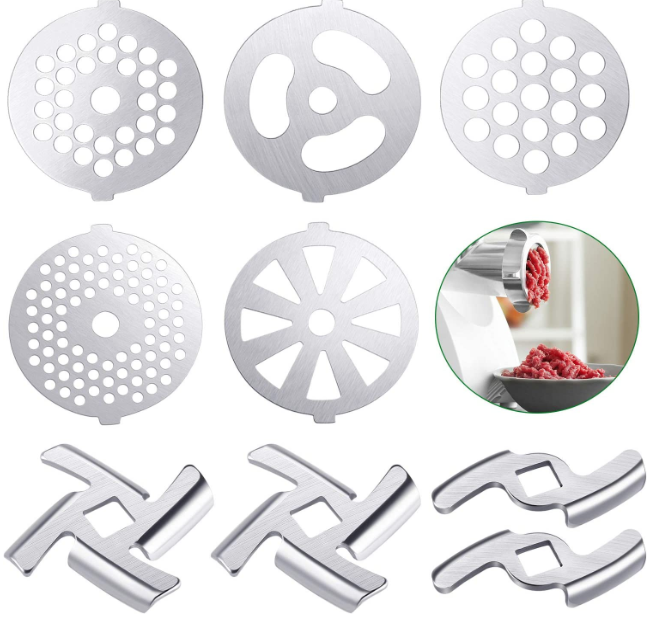
Understanding Cutting Plates and Blades: Cutting plates and blades are essential components of a meat grinder that determine the texture and consistency of the ground meat. Together, they slice, chop, and ground the flesh to create the correct shape.
Different Types of Cutting Plates and Blades: Meat grinders typically offer various types of cutting plates and blades to accommodate different grinding needs. Here are some common options:
- Fine Cutting Plates and Blades: These are ideal for producing fine and smooth ground meat, perfect for recipes like sausages, meatballs, and spreads. They are often denoted by a smaller number of cutting edges, resulting in finer mincing.
- Medium Cutting Plates and Blades: Medium cutting plates and blades strike a balance between texture and tenderness. They work well for recipes that call for a little coarser grind, like meatloaf, casseroles, and burgers.
- Coarse Cutting Plates and Blades: Coarse cutting plates and blades are designed to produce a more substantial grind with visible meat texture. They are commonly used for recipes like chili, stews, and ground meat toppings.
- Specialty Cutting Plates and Blades: Some meat grinders offer specialty options, such as grinding plates with different hole sizes or blades with unique shapes. These allow for specific grinding purposes, such as creating different meat textures or even processing vegetables.
Choosing the Appropriate Cutting Plates and Blades: To choose the appropriate cutting plates and blades for your requirements, consider the following:
- Recipe Needs: Determine the type of recipes you plan to prepare most frequently and the desired texture of the ground meat. This will help you decide which cutting plates and blades are best suited for your needs.
- Versatility: If you want the flexibility to create different textures, consider a meat grinder that comes with multiple cutting plates and blades, allowing you to adjust the grind coarseness as needed.
- Compatibility: Ensure that the cutting plates and blades you choose are compatible with your meat grinder model. Check the specifications provided by the manufacturer or consult the product manual for compatibility information.
It’s important to note that certain meat grinders also let you alter the distance between the cutting plates and blades in order to change the grind size. This enables the texture of the ground meat to be further customized.
Key Factor 6: Ease of Use and Cleaning
The simplicity of use and cleanliness of a meat grinder are important considerations because they have a direct impact on your entire experience and the appliance’s longevity. You will save time and effort operating and maintaining a grinder if it is simple to use and clean.
Features that Improve Convenience and Usability: To make a meat grinder more convenient and usable, look for the following features:
- Intuitive Controls: A meat grinder with simple and intuitive controls makes it easy to operate, allowing you to quickly switch between functions or adjust settings without confusion.
- Large Feed Tray: A spacious feed tray provides ample space for loading meat, reducing the need for frequent reloading and making the grinding process more efficient.
- Reverse Function: The inclusion of a reverse function is beneficial, as it helps clear any blockages or jams that may occur during grinding, ensuring smooth and uninterrupted operation.
- Suction Base or Clamps: Look for a meat grinder that comes with a suction base or clamps to secure it firmly to the countertop. This provides stability and prevents the grinder from moving or sliding during use.
Follow these cleaning and maintenance recommendations to keep your meat grinder in top working order:
- Disassembly: Before cleaning, make sure the grinder is unplugged and take it apart as directed by the manufacturer. Remove all detachable parts, such as the cutting blades, grinding plates, and food tray.
- Hand Washing: Wash the detachable parts with warm, soapy water using a gentle brush or sponge. Pay close attention to removing any meat residue or grease. Avoid submerging the motor or any non-removable parts in water.
- Drying: Thoroughly dry all parts after washing to prevent moisture buildup, which can lead to rust or damage. Air-drying or using a clean towel are suitable methods.
- Lubrication: Some meat grinders may require periodic lubrication of the moving parts. If maintenance is required, check the manufacturer’s instructions and use the suggested lubricant.
Regular Inspection: Periodically inspect the grinder for any signs of wear or damage. Check the cutting blades, grinding plates, and gears for sharpness and integrity. Replace any worn or damaged parts as needed.
Key Factor 7: Safety Features
Importance of Safety Features in Meat Grinders: Safety should be a top priority when using any kitchen appliance, including meat grinders. The presence of proper safety features not only protects you from potential accidents but also ensures that the grinder operates smoothly and efficiently.
Important Safety Features to Consider The following crucial safety features should be taken into consideration when choosing a meat grinder:
- Locking Mechanism: During use, the cutting blades and grinding plates of the grinder must remain firmly in place thanks to a reliable locking mechanism. This stops accidental shifting or removing that might result in harm.
- Overload Protection: Look for grinders with built-in overload protection mechanisms. These features automatically shut off the motor if it becomes overloaded or overheated, preventing damage to the grinder and minimizing the risk of accidents.
- Safety Switch: A safety switch or button that needs to be pressed or engaged before the grinder starts operating adds an extra layer of protection. This ensures that the grinder doesn’t accidentally start when not intended, reducing the risk of injuries.
- Food Pusher or Stomper: You can safely direct the meat into the grinder without using your hands by using a food pusher or stomper, which is a useful tool. It aids in maintaining a safe space between your fingertips and the parts of the grinder.
Ensure secure usage and operation: Follow these instructions for safe meat grinder use and operation:
- Consult the manual: Read the user handbook to become familiar with the manufacturer’s instructions and safety recommendations. You will have a better understanding of the specific safety features and usage guidelines for your meat grinder as a result.
- Supervision and Caution: Always operate the meat grinder under adult supervision, especially when children are present. Exercise caution and avoid distractions while using the grinder to minimize the risk of accidents.
- Proper Assembly: Verify that the grinder has been put together correctly and that all of the parts are linked before using it. Improper assembly can lead to malfunctions or accidents during operation.
- Clear Workspace: Keep your workspace clean and free from clutter. Remove any obstacles or objects that could interfere with the grinder’s operation or cause accidents.
Maintenance and Inspection: Regularly inspect the grinder for any signs of wear, damage, or malfunction. Maintain and clean the grinder as per the manufacturer’s instructions to ensure its safe and efficient operation.
Key Factor 8: Noise and Vibration
Noise and vibration have an impact on your entire user experience and the area in which you use the appliance, therefore they are vital aspects to take into mind when choosing a meat grinder. Excessive vibration and noise can be bothersome, uncomfortable, and could be a sign of poor construction or malfunction.
When assessing meat grinders, take into thought the following factors regarding noise and vibration levels:
- Decibel Level: The decibel (dB) level of the noise the grinder makes is an indication of its intensity. To reduce noise, look for meat grinders with lower dB values. Some manufacturers include details regarding noise levels in the user guides or product specifications.
- Anti-Vibration Features: Check if the meat grinder has built-in anti-vibration features or technologies. These can help reduce vibrations and stabilize the grinder during operation, resulting in smoother and quieter performance.
- Customer Reviews: Reading customer reviews can provide insights into the noise and vibration levels of specific meat grinder models. Look for feedback regarding the noise produced during operation and any excessive vibrations experienced by users.
Finding a Meat Grinder with the Least Vibration and Noise: Here are some recommendations for choosing a meat grinder with less vibration and noise:
- Research and Comparison: To identify grinders that have become popular for their silent operation and low vibrations, conduct in-depth research and compare several types. Choose reliable companies that have a focus on stability and noise reduction.
- Noise Reduction Technology: Some meat grinders may incorporate noise reduction technology, such as sound-insulated casings or dampening materials, to minimize noise. Look for grinders that mention these features in their product descriptions.
- Quality Construction: Opt for meat grinders made from high-quality materials and solid construction. A well-built grinder is less likely to produce excessive noise or vibrations during use.
- User Feedback: Pay attention to user feedback and reviews that specifically mention noise and vibration levels. This can give you firsthand insights into the real-world performance of different meat grinder models.
Key Factor 9: Price and Warranty
Setting a Budget for a Meat Grinder: It’s important to decide on a budget that suits your demands and tastes before making a meat grinder purchase. To choose a suitable pricing range, think about how frequently you’ll use the grinder and the specific features you need.
Understanding the Relationship between Price and Quality: Price often reflects the quality and performance of a meat grinder. While more expensive models might come with cutting-edge features, a more sturdy build, and increased durability, it doesn’t mean a less expensive choice won’t satisfy your needs. Finding the right balance between your spending limit and the desired quality is essential.
Evaluating Warranty Options and After-Sales Support: When selecting a meat grinder, pay attention to the warranty offered by the manufacturer. A warranty provides assurance that the company stands behind its product and is willing to address any issues that may arise. Consider the following points regarding warranty and after-sales support:
- Warranty Duration: Check the duration of the warranty coverage. Longer warranties typically indicate the manufacturer’s confidence in the product’s quality. It’s advisable to opt for a meat grinder with a warranty that aligns with your expectations and the price you’re paying.
- Warranty Coverage: Understand what the warranty covers. It should include protection against defects in materials and workmanship. Some warranties may also cover specific components, such as the motor or other key parts. Look over the warranty to discover if there are any restrictions or exclusions.
- After-Sales Support: Research the manufacturer’s reputation for after-sales support. Prompt and reliable customer service can be valuable if you encounter any issues or have questions about your meat grinder. Look for brands with a track record of responsive and helpful customer support.
- Product Reviews: Reading customer reviews and testimonials can provide insights into the reliability and durability of a meat grinder. Look for feedback regarding the warranty process, customer service experience, and any issues encountered by users.
While cost and warranty are essential considerations, they shouldn’t be the only ones used in your decision-making process. Think about all the important elements included in our buyer’s guide and strike a balance between cost, value, and warranty protection that best meets your requirements and tastes.
Get your perfect meat grinder now on Amazon and elevate your cooking experience!
Summary:
Choosing the right meat grinder is essential to enhance your culinary experience and achieve the desired results in meat preparation. Throughout this comprehensive buyer’s guide, we have discussed nine key factors to consider before purchasing a meat grinder. Let’s recap these factors:
- Grinder Type: Electric, manual, or standalone – choose the type that suits your needs and preferences.
- Power and Motor Strength: Determine the appropriate power and motor strength based on your usage requirements for efficient grinding.
- Grinding Capacity: Evaluate the grinding capacity of the grinder and choose one that meets your needs, considering factors like batch sizes and frequency of use.
- Material and Durability: Consider the material used in the grinder’s construction and ensure it is durable and built to last.
- Cutting Plates and Blades: Understand the different types of cutting plates and blades available and select ones that align with your desired grinding results.
- Ease of Use and Cleaning: Look for features that enhance usability and convenience, and follow proper cleaning and maintenance practices for optimal performance.
- Safety Features: Prioritize grinders with essential safety features to ensure safe and accident-free operation.
- Noise and Vibration: Evaluate the noise and vibration levels of the grinder to choose a model that provides a quieter and more comfortable experience.
- Price and Warranty: Establish a budget, balance cost and quality, and take into consideration the warranty terms and the manufacturer’s post-purchase assistance.
By carefully taking into mind these elements, you may choose a meat grinder that best meets your requirements, tastes, and price range. It’s important to keep in mind that the correct meat grinder will improve your cooking experiences, save you time, and give you excellent, finely ground meat for a variety of gourmet masterpieces.
Frequently Asked Questions (FAQs)
- What is the best type of meat grinder for home use?
- Electric meat grinders are generally the most popular and convenient choice for home use due to their ease of operation and consistent performance.
- Can I grind bones with a meat grinder?
- Not all meat grinders are designed to handle bones. Make sure you get a grinder made specifically for grinding bones if you want to grind bone.
- How often should I clean my meat grinder?
- It is recommended to clean your meat grinder thoroughly after each use to maintain hygiene and prevent the buildup of bacteria. Regular cleaning ensures optimal performance and longevity of the appliance.
- Are electric meat grinders more powerful than manual ones?
- Yes, electric meat grinders are generally more powerful than manual ones. Electric grinders offer higher motor strength, which results in faster and more efficient grinding.
- How long does the average meat grinder last?
- The quality of the product and how frequently it is used can affect a meat grinder’s longevity. A well-kept meat grinder can often survive for several years.
- Can I use a meat grinder for other food items besides meat?
- Yes, meat grinders can be used for grinding various food items such as fruits, vegetables, nuts, and more. However, make sure to refer to the manufacturer’s guidelines and use appropriate attachments.
- Are all meat grinders dishwasher-safe?
- Not all meat grinders can be put in the dishwasher. To find out if the grinder and its parts can be cleaned in the dishwasher, it’s crucial to read the manufacturer’s instructions.
- Which safety measures must I follow when using a meat grinder?
- Some safety precautions to follow when using a meat grinder include wearing protective gloves, avoiding wearing loose clothing or jewelry, and ensuring the grinder is securely assembled before operation.
- How can I tell if a meat grinder is right for use in a commercial setting?
- Commercial meat grinders are typically larger and more powerful than those intended for home use. Look for models specifically labeled as commercial-grade and capable of handling high-volume grinding tasks.
